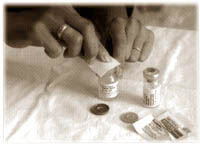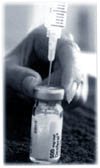DESFERAL ADMINISTRATION
How to mix your Desferal
- The first thing you need to do before you begin mixing is the most important step when
mixing your Desferal: Wash your hands with soap and water for 3 minutes!
Unclean hands can cause infection.
- If you are using Emla cream or a patch, place the anesthetic a half hour to an hour
before preparing for infusion. If you are using a spray, use immediately before inserting
your sub-Q needle.
- Lay out all supplies on a clean table or flat surface, preferably on a sterile drape or
clean towel.
- Open all bottle tops, needle and syringe packages.
Try to keep everything as sterile as possible.
Ways to do this include:
- Keep everything on or in the sterile packaging.
- Do not touch the open parts of the tubing, needles or tops of the Desferal and sterile
water bottles.
-
 Wipe all sterile water and Desferal vials with alcohol pads (make sure you
have enough since you will be sterilizing the vials a couple of times).
Wipe all sterile water and Desferal vials with alcohol pads (make sure you
have enough since you will be sterilizing the vials a couple of times).
- Attach straight needle to syringe and fill with air. Don't touch the needle of tip of the
syringe!
- Insert needle into sterile water vial. Slowly push the air into the vial.
Turn vial over and draw out precribed amount of sterile water. Remove needle from vial.
-
 Slowly add sterile water to each Desferal vial (your doctor or nurse will tell you how
much water you need for each vial of Desferal).
Slowly add sterile water to each Desferal vial (your doctor or nurse will tell you how
much water you need for each vial of Desferal).
- In order for the Desferal to dilute, you need to mix the sterile water and Desferal.
Put the vial between the palms of your two hands and rub them back and fourth.
This will help the Desferal dilute. Do not shake it! Once the liquid is clear
and there is no trace of white powder, then the Desferal is completely diluted and ready
to use. If the liquid appears cloudy, do not use that vial. Keep it to show your nurse,
doctor or the healthcare company who supplies your Desferal, and start with step one with
a new vial!
- Wipe the tops of all Desferal vials with a new sterile alcohol pad.
Insert the straight needle with the syringe attached into vial and draw out the diluted Desferal.
Once all the vials are drawn, take the straight needle off the syringe and discard it
in the sharps container.
- Connect the syringe to one of the tubing. Apply a sterile sub-Q needle to the other end.
Fill the tubing with diluted Desferal until a small drop comes out the end of the needle.
- Strap the syringe to the pump. Lock by screwing the clamp located on the side of the pump.
Make sure it is securely on the pump and that the battery works.
- Using a Povidone-Iodine pad, scrub the area where you plan to infuse the Desferal and wait
2 minutes. Clean off the iodine with a new sterile alcohol pad.
- Find a spot on your abdomen, arm or leg (or any soft fleshy area) to insert your needle. It is important that you rotate places you stick yourself so that you give some time for bumps and rashes to heal. If you are using anesthetic spray, spray on the site of infusion. Insert needle into skin.
- Securely tape the needle and tubing. Start pumping!
If you have any questions about how to do your Desferal, contact your health care provider.












